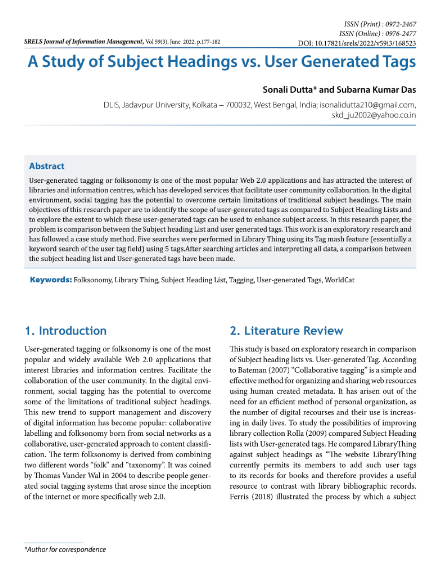A Study of Subject Headings vs. User Generated Tags
DOI:
https://doi.org/10.17821/srels/2022/v59i3/168523Keywords:
Folksonomy, Library Thing, Subject Heading List, Tagging, User-generated Tags, WorldCatAbstract
User-generated tagging or folksonomy is one of the most popular Web 2.0 applications and has attracted the interest of libraries and information centres, which has developed services that facilitate user community collaboration. In the digital environment, social tagging has the potential to overcome certain limitations of traditional subject headings. The main objectives of this research paper are to identify the scope of user-generated tags as compared to Subject Heading Lists and to explore the extent to which these user-generated tags can be used to enhance subject access. In this research paper, the problem is comparison between the Subject heading List and user generated tags. This work is an exploratory research and has followed a case study method. Five searches were performed in Library Thing using its Tag mash feature (essentially a keyword search of the user tag field) using 5 tags. After searching articles and interpreting all data, a comparison between the subject heading list and User-generated tags have been made.Downloads

Downloads
Published
How to Cite
Issue
Section
License
All the articles published in Journal of Information and Knowledge are held by the Publisher. Sarada Ranganathan Endowment for Library Science (SRELS), as a publisher requires its authors to transfer the copyright prior to publication. This will permit SRELS to reproduce, publish, distribute and archive the article in print and electronic form and also to defend against any improper use of the article.
References
Adamich, T. (2014). The Sears List -- An Old Friend With A 21st Century Look. Library Media Connection, 32(4), 43.
Bateman, S. (2007) “Collaborative Tagging : Folksonomy, Metadata, Visualization, e-Learning, Thesis.” HARVEST, University of Saskatchewan, 1 Dec. 2007, https://harvest.usask.ca/handle/10388/etd-12112007-221606.
Ferris, A. M. (2018). Birth of a subject heading. Library Resources & Technical Services, 62(1), 16-27. DOI: https://doi.org/10.5860/lrts.62n1.16
Hayman, S. (2007) “ FOLKSONOMIES AND TAGGING: New Developments in Social Bookmarking .” Ark Education, Ark Group Conference: Developing and Improving Classification Schemes, http://citeseerx.ist.psu.edu/viewdoc/download?doi=10.1.1.138.8884&rep=rep1&type=pdf. Accessed 16 Jan. 2022.
Mas, M.D. (2012) “Intelligent Interface Architectures for Folksonomy Driven Structure Network,” 2012 Sixth International Conference on Complex, Intelligent, and Software Intensive Systems, 2012, pp. 519-525, https://doi.org/10.1109/CISIS.2012.158 DOI: https://doi.org/10.1109/CISIS.2012.158
Petek, M. (2012). Comparing user-generated and librariangenerated metadata on digital images. OCLC Systems and Services: International Digital Library Perspectives, 28(2), 101 -111. https://doi.org/10.1108/10650751211236659. DOI: https://doi.org/10.1108/10650751211236659
Rolla, P. (2009). User Tags versus Subject Headings. Library Resources & Technical Services, 53(3), 174-184. https://doi.org/10.5860/lrts.53n3.174 DOI: https://doi.org/10.5860/lrts.53n3.174
Samadder, H. (2019). Subject Heading List Vs User- Generated Tags: A Case Study (dissertation). Rabindra Bharati University, Kolkata, West Bengal.
West, W (2013). Tag, You’re IT: Enhancing Access to Graphic Novels. Portal: Libraries and the academy, 13(3), 301-324 DOI: https://doi.org/10.1353/pla.2013.0023

 Sonali Dutta
Sonali Dutta








